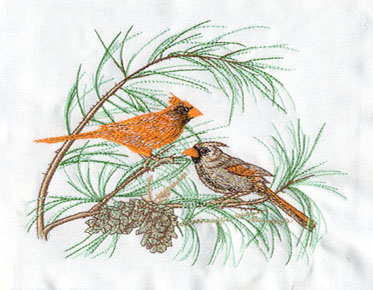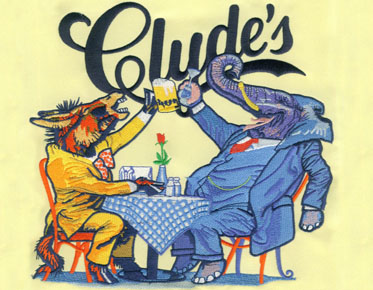The Types of Stitches in Machine Embroidery and Digitizing
If you're interested in creating
machine embroidery digitizing designs,
you'll need to know a few things about the various stitches that are available.
Here are the basic types of stitches: Straight Stitch: Used for outlines and
straight lines, this type is often seen on clothing pockets or to outline the
words in a design. Zigzag: These stitches can be used anywhere in your design,
but they tend to look best when used around curved edges. Blending Threads:
Choose this option if your design has multiple colors and you want them to
blend well into each other.
Straight stitch
The straight stitch is the most basic
and common stitch in machine embroidery. It is used to outline or fill small
areas of fabric, such as acronyms or other text.
In digitization, this type of stitch
is also referred to as a "solid" or "running" stitch
because there are no gaps between them (which can make it look staccato).
Running stitch
Running stitches is a simple but
effective way to add stitches to your design. It is an excellent choice for
small detail work and can be used for embroidery or embroidery digitization
services.
Running stitches involve sewing the
same piece of fabric over and over, with small changes between each repetition.
This provides fine details that are difficult or impossible to achieve by hand
sewing alone (e.g., tiny stitches through several layers). The result is an
image that looks like it was stitched together using many individual parts
instead of one continuous thread - and perfectly aligned every time!
Zigzag stitch
Serrated stitches are used to create
decorative lines. It can be used to applique, add detail to a design, or make
waves in a design.
A stitch is also called a spool, warp,
or weave because it creates an almost continuous line that looks like an object
is being warped (or braided) into place on the fabric.
The easiest way to use this stitch is
to place one pin vertically down on the top of the work piece and then move it
from left to right until it reaches the other pin along its length.
Satin or column stitch
Satin stitches are used to create
smooth lines and edges. It is also used on the right side of fabric, where it
looks more even than other stitches.
We can make satin stitches in two
ways:
It has an open circle motion (top) or
a closed circle motion (bottom). This will depend on what you want to achieve
with your project. In general, however, we recommend using only one pass knot
per round. This prevents wear and tear at the ends of each line and ensures
that there are no gaps between the lines when multiple parts are stitched
together.
Filled stitch
The filling stitch is used to fill the
background of the design. They can be used to create patterns or fill areas
with solid colors. Filling stitches are usually straight or curved lines that
touch each other at their ends and form a pattern in the fabric.
The most basic form of stuffed stitch
consists of a long, continuous thread running through the fabric from top to
bottom (or along its length). Easy for beginners, but versatile enough for
experienced sewers!
Pin of design
A pattern stitch is a single shape,
usually a letter or number. One can use them to create designs and monograms in
embroidery.
Stitch of text
A text stitch is used to create a
small embroidery area. You can use them to create names, phrases, or short
messages in your design. Stitch types are often used with satin stitch to
create monograms or borders around text.
Border stitching
Border stitches are used to provide
decorative edges to your design. The border stitch can be straight, serrated,
or satin. Border stitches can also be used to create scallops or swirls in
embroidery designs.
Applique stitching
A decal stitch is used to add a design
on top of the main design. They are also used in decals, a technique of
stitching multiple parts together to create one-of-a-kind pieces. Nevertheless,
if you want to digitize your logo, get a professional logo embroidery
digitization service.
Butterfly/open butterfly back
embroidery
A butterfly stitch is a single stitch
that is open on one side and curved on both sides. It looks like a butterfly
with open wings. This type of stitch is used for all types of fabrics,
including knitwear and silk, as well as when making clothing.
The seam
This type of stitch is similar to open
back embroidery, but with two lines meeting at an Angle instead of just one.
You can do a single backstitch by attaching multiple layers to this type of
stitch. Reverse embroidery is often used for decorative purposes, such as
adding embroidery or decals to clothing or other items.
Running stitch
Running stitches usually consist of
multiple stitches that are threaded through different fabrics at the same time
to give them more stability or shape (e.g. hem). Running stitches makes it
easier for you to sew threads quickly because they can be made up of any number
of different types of stitches.
Here's why we use different types of
stitches
When sewing, you may want to use a
different stitch for each purpose.
Here's why:
You can sew several layers of fabric
at a time using a straight needle made from a single needle.
You can create decorative stitches,
such as zigzag and satin, also for quilting and embroidery.
You can use a running stitch or a
negative stitch to adjust the tension on the machine to ensure the seams are
perfectly aligned and in the correct position.
Different materials require different
types of stitches.
You are creating a design that
requires a specific type of stitch.
Your project needs a specific type of
stitch to get the best look or feel.
We hope you've learned a lot about the
different types of stitches used in machine embroidery and the stitches used in
embroidery digitizers. If you have any questions or comments, please feel free
to contact us! We are always here to help you.



